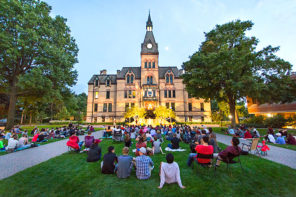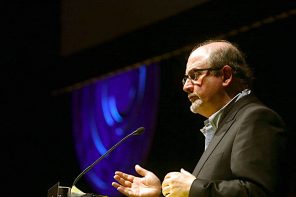A Pakistani, a Turk, and a Bosnian pray in a wooded mountain (the very translation of the Turkic word “Balkan”) next to a log cabin mosque. It sounded like the introduction to a joke, upon which point all of us agreed, and then we returned to our quiet reflection. We were on one of the few mountains the Bosnians held during the siege of Sarajevo, and in the dead of winter, their soldiers had built this mosque. From its fat, wooden minaret, a petite green flag with a white crescent and star hung limply.
That is not one of Bosnia’s (recent) flags, at least not if you’re looking back within the last hundred years. At independence in 1992, the country chose a white flag with a blue and gold shield, containing six fleur de lis, what was supposed to be a neutral symbol of a pre-Islamic Bosnia, around which Christians, Jews, and Muslims could rally. But it didn’t stick, as proved by Bosnia’s post-war flag. It is, like many compromises, a case of everyone having lost.
Bosnia’s ended up with an overwhelming fluorescent blue and yellow banner, which best evokes an abstract corporate marketing exercise, or perhaps a high-end luxury pattern that might only succeed in the Gulf. That may explain why this flag unsuccessfully competes with flags from other times and places. Considering how tenuous modern Bosnia is, it’s no wonder every side has to supplement its identity with other flags.
In the Croat neighborhoods of Mostar, shiny new Croatian flags jut out from every telephone pole. When we drove into Republika Srpska later that day, a shiny tricolor flag hung horizontally, and because the order of the colors seemed reversed, I thought I was looking at Russia’s flag.
This is not just nationalism, but something more elemental: Much like Pakistan, it seems there’s no Bosnia without a Muslim identity. (What is a Bosniak, if Catholic Bosnians are just Croats, and Orthodox Bosnians are just Serbs?) The logic of this indeterminacy plays out in the symbols Bosniaks surround themselves with. Some Bosniaks fly the very old Ottoman standard of three white crescents on a green background. In the café I’m sitting in right now, there’s no official Bosnian flag in sight. But there are Turkish and Palestinian flags, while Muslim pop songs by British superstar Sami Yusuf blast on repeat.
Each of Bosnia’s constituent peoples sees itself as the farthest end of their respective civilizations, whose essences, based on the flags at least, are found elsewhere. Bosnia isn’t a place, then, it’s an intersection, and at dark times, an unfortunate collision. Thus Bosniaks remark that they’re holding the line. If they fall, “Muslim territory” will continue its retreat south and east of the Mediterranean. This has happened before—and they point to Iberia’s Muslim past, beautiful, brilliant, expired; although they do not know exactly how or when, they look at the other flags fluttering, they suspect who might be responsible.
There are flutters of optimism, of course, but from what I hear, they do not sound genuine. It’s not hard to see why. But I feel there are signs here, deeper indicators of possible improvements, and perhaps my unavoidable American optimism forces me to focus on them. The McDonald’s slated to open later this month, billboards for which seem to outnumber actual Sarajevans: there’s investment here. And there’s the strong potential for tourism, seeing as the country, overrun by war, is outstandingly pristine. Many Bosnians drink straight from the rivers around them.
Bosnia’s nature, ecological but also cultural, might be its saving strength. Bosnia seems both in Europe and somehow long ago secluded from it; it has stepped to the side and excused itself from the way the world is supposed to work. It is historically unique, and profoundly diverse. Its differences are not the effect of recent immigration, global capital or racialized colonialism with its back-and-forth flows of elites and subalterns. Rather, Bosnia’s made of very old cultures sitting side-by-side; Sarajevo was, for good reasons, called Europe’s Jerusalem—a place where the Abrahamic faiths mingled in a historic proximity alien to modern Europe. Would that it could be that way again.
On trips such as these, I often meet spiritual seekers. In its history, and destiny, I can see tiny Bosnia becoming a home for many such Western Muslims, ourselves small in number, eager for a cultural reference, and desperate for a relevant and rooted spirituality. While southern Spain has that kind of draw, it cannot help but evoke a vanished people whose absence deflates every present moment. And though Turkey will have impact enough on Islam worldwide, it is too big, too overwhelming, and perhaps not quite Western enough to do what Bosnia can. Bosnia is small enough to put in your pocket, and kind enough to want to; it is easy to explore, and beautiful enough to fall in love with. There is something strange about Bosnia that way.
Tuesday night at Sarajevo’s Gazi Husrev Beg mosque, the main Ottoman monument, the congregation is rows deeper than I expected. The worshippers are either old or young. The middle-aged remain turned off by their Communist inheritance, congregants tell me, while the old never lost their faith and the young have rediscovered it. Translations of books by prominent Western Muslims sit on nearby store shelves; the manners and dresses of the pious reflect not Turkish styles but seem indistinguishable from Muslim habits in England or America.
For someone used to visiting Muslim countries, the casual state of dress is surprising—Turkey, supposedly so “European” and “secular,” has nothing on this. My wife and I joke that the beautiful people might be a lure in themselves. But it’s much more. The people are unbelievably hospitable, resilient in the face of tragedy; they reference loved ones who died, cry openly over their losses, and ten minutes later, tease one another with abandon. This warmth and liveliness has been the most surprising thing about Sarajevo.
Each night, the streets are frenetic with people, and I found myself surrounded by tourists from all over the world, apparently arriving in increasing numbers. It’s possible that, with European Union membership, all three “constituent people” would be too small to indulge their anxieties. The idea of civilizations colliding is less genuine than cultures overlapping, opposing flags rightly transformed to markers of reference, not destinations or prohibitions. An historic openness could be rediscovered, for its outlines still survive in this city. Most all its churches and synagogues still stand.
And so I went back—the last thing I did with my free time. On Wednesday morning, after I woke up and showered, I went to Gazi Husrev Beg, climbed onto the patio and prayed. Behind me I could hear ablution fountains splashing, the sounds of a city waking up, a madrasa student practicing his lessons; and I didn’t want to leave. As its designer would have intended, and as religious architecture has long believed, what we are surrounded by will dictate who we are likely to become.
It looks, from the outside, deeply Ottoman, but there’s something here I haven’t found elsewhere. Ottoman mosques, with their dull gray stone, ambitious minarets, and imposing presence, are something else. It might mean something that the man whose endowment established this mosque had no children of his own, and saw this structure as his legacy for the world. We’re used to monumentalism in sacred spaces, the deployment of largeness for the purposes of producing epiphanies. There is however a sustained tradition in Islamic aesthetics of smallness cultivating and sustaining piety, incorporating tiny gestures, subtle symmetries, and easily overlooked details, whose full effect is to cause us to go meekly, and not grandly, beyond ourselves.
What else are we to make of his mosque, with its pastel salmon and muted turquoise calligraphies lost against wide and worn white spaces, only infrequently interrupted by indulgences of a blue slightly darker than the sky? Its inside is much larger than the smallness its outside seems to permit, its charmingly insufficient chandeliers seem to bring to mind a reverent sleepiness, and its mismatched carpets are unable to cover all its vulnerable floor.
Sarajevo was never a mighty city, but a prosperously unpretentious Ottoman capital from an age whose culture is often forgotten. Just a little corner of the world, its closeness to us—a few hours to London, and fewer to Istanbul—seems, on reflection, unbelievable, absent as it is from the world’s considerations and calculations. Bosnia is, in a word, overlooked. It is on the other side of sacred, not grand and universal, but small and intimate, though both perspectives allow us to overcome ourselves and feel a profound connection with the true nature of things.
Thus Istanbul and Sarajevo seem an aptly opposing pair, the one illuminating the other. When you think of Istanbul, it’s as a place where, for a very long time, history was made and will be again. Armies streamed in to change it, and streamed out of it to conquer the world. Istanbul can take care of itself. But Sarajevo you would like to keep safe from the world and its injustices, a city to embrace and be embraced by, for although it is not the kind of place that makes history, still, cruelly, it has not been given any respite from it.




